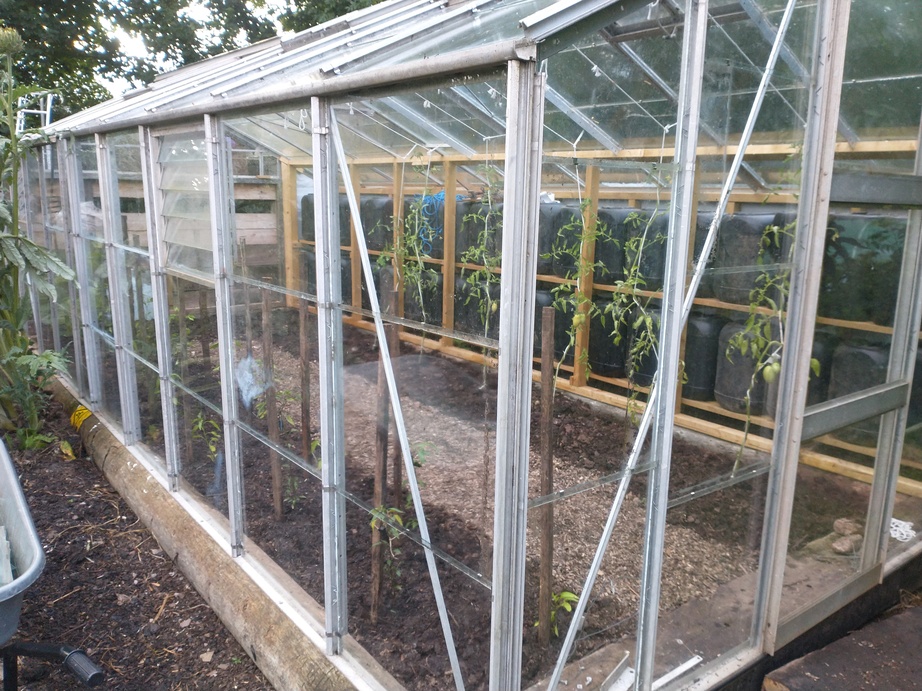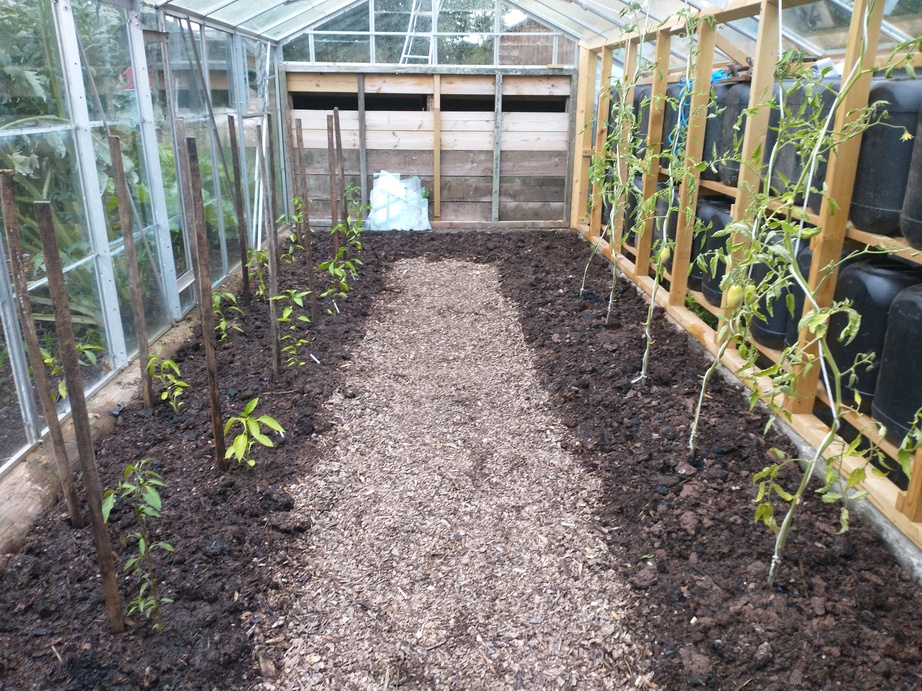Well, it's taken quite a while to get this far, but Frankenstein's Greenhouse is basically finished now, bar a few small odds and ends that need finishing off:
Why Frankenstein's Greenhouse? Well, to start off with, it's all something of an experiment.
I've been wanting to build a greenhouse with some sort of solar heat storage to extend the growing season for plants such as peppers and tomatoes for a while. One way that's sometimes done is to bury perforated pipes up to a metre deep in the soil beneath the greenhouse and use solar power to blow warm air from the top of the greenhouse into the pipes. The ground then becomes a large "heat battery", storing heat that can is used to warm the same air at times when the greenhouse gets cooler. Unfortunately my situation really doesn't lend itself to such an arrangement because the soil isn't very deep and the rock beneath is very porous, meaning any buried pipes would probably just fill up with water.
So I took a slightly different approach. The right hand wall in the photos is stacked with twenty litre containers that used to contain dairy hypochlorite. They're now filled with water, and being black will absorb heat as the temperature in the greenhouse rises. The far wall is actually the back wall of two compost bins that I hope I can maintain at over 40°C once they get going, with some of the heat rising off the heaps coming through the gap in the wall into the greenhouse itself. These two heaps will be used for all of the food waste that used to get put out for the council recycling collection (cooked food, basically) and, as soon as I finish it, the "contents" of my compost toilet. Later in the year I intend to line all the glass with horticultural bubble wrap to increase the insulation.
There's another thing it has in common with Dr. Frankenstein's creation however: as I've posted before I have little meaningful income at the moment, so as far as possible this entire project has been stitched together from all sorts of bits other people didn't want or that I found lying about unused. The greenhouse frame itself is actually made from parts of two completely different greenhouses -- different shapes and heights and produced by different companies. Possibly they're antiques

One even had sloping sides whilst the other's were vertical. They both came to me via Freecycle. I've put them together to make a single greenhouse about six metres long and two and a half metres wide. The base is made from a disused telegraph pole abandoned by BT almost twenty years ago, a disused electricity transformer pole that I got the contractors to leave behind when they replaced it, and three railway sleepers left over from another project. Some of the glazing came with the greenhouses; most of the rest from at least two others (some via Freecycle again). Two sheets are actually sliding doors from a glass-fronted cabinet. The compost bins are made using a mixture of broken up pallets, recycled decking, sides from a raised bed that was removed and bits of the old chickens' bird flu winter quarters that I took down last year. I did use some new featheredge boards (which also cover the wall behind the water containers) for the lids and fronts. The fronts are retained using pieces from an offcut of electrical conduit and offcuts from an oven shelf that I needed to make smaller to fit in my smoker. The main things I had to buy were the featheredge boarding and the timber for that wall and the racks holding the water containers. I did also need a few more glazing clips and bolts to assemble the greenhouse frame and hold the glazing in place. Oh, and some nails.
I had some left-over tomatoes and peppers in pots that I'd saved so that's what's planted in the beds at the moment. I'm also going to plant some pineapples that I have in pots. I've no idea if they'll fruit, but it will be fun finding out. I only actually put the door on after lunch today (easier to shovel in the compost and woodchip without it), but even so the water containers felt warm to the touch by about 8pm this evening.
Now I just need to get the compost toilet finished... Oh, and get rid of a wheelbarrow load of waste glass.
James
Thanks to some "creative" cutting I might possibly even manage to get the entire job done in glass. It's meant I've used more glazing clips and so on, but they're no use sitting around on the workshop shelves like they have been for the last ten or possibly even fifteen years.
























































